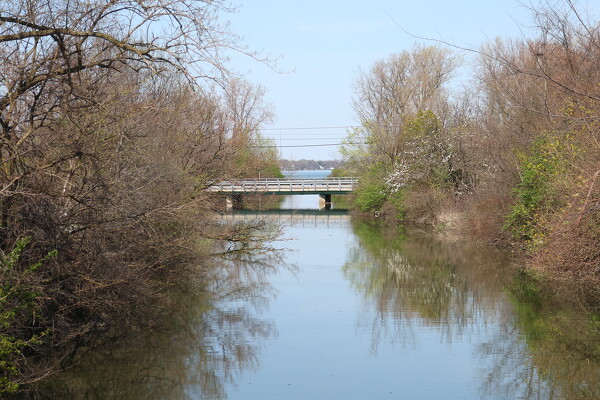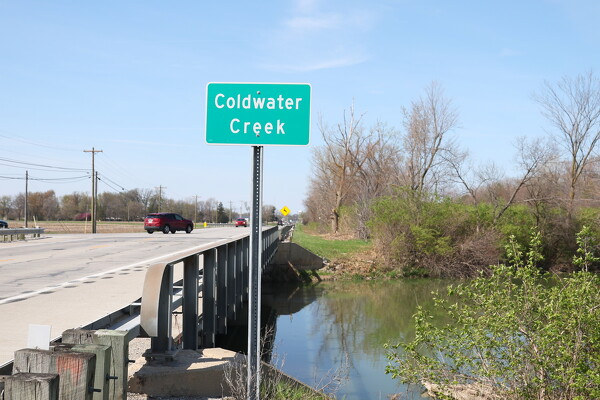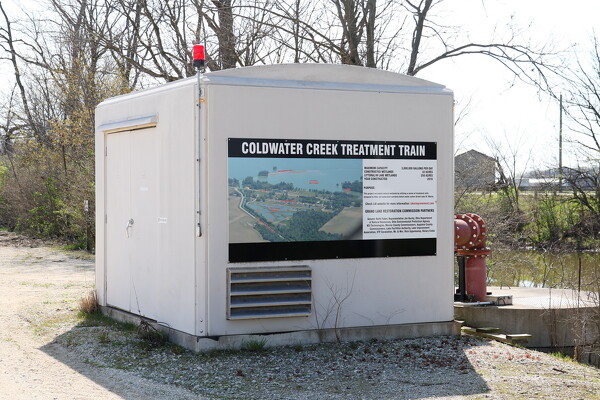Wednesday, April 23rd, 2025
The Science of Wetlands
Published article highlights local water quality efforts
By William Kincaid

Photo by Paige Sutter/The Daily Standard
The Coldwater Creek Treatment Train, built on a former 40-acre farm field, was completed in 2016 at a cost of $2.1 million. The treatment train is the primary subject of a new study published in Wetlands, a prestigious international science journal.
CELINA - Area experts working to restore the water quality of Grand Lake have authored a study demonstrating the efficacy of restored and managed wetlands that was accepted for publication in a prestigious international science journal dedicated to pioneering work across all aspects of wetland research.
"Wetland Conservation in the Grand Lake St. Marys Watershed: Long Term Monitoring Data from Coldwater Creek Restored Wetland," credited to Wright State University-Lake Campus biology professor Stephen Jacquemin, his research assistant Morgan Grunden and Mercer County Agriculture and Natural Resource Director Theresa Dirksen, appears in Volume 45 of Wetlands.
"This is an exciting thing to see out there," Jacquemin said at this month's Lake Improvement Association meeting. "It'll be the first of many (articles) specific to the sort of history of wetlands in the region and how these wetlands are actually doing."

Photo by Paige Sutter/The Daily Standard
The wetlands, situated on 25 acres of land, represents a mere 0.3% of the entire Grand Lake St. Marys Watershed area yet has sequestered 5% of all phosphorous.
Littoral wetlands make up treatment trains established at Coldwater, Prairie, Beaver and Big Chickasaw creeks that filter out nutrients responsible for toxic blue-green algal blooms in Grand Lake.
Nutrient runoff comes from many sources, but in the Grand Lake Watershed, studies show it's mostly from farmland in the 58,000-acre, livestock-heavy watershed.
Recognized as the official journal of the Society of Wetland Scientists, Wetlands publishes high-quality, peer-reviewed articles from leading authors in the field exploring all aspects of wetlands biology, ecology, hydrology, water chemistry and soil and sediment characteristics, according to its editor-in-chief, Marinus L. Otte.
"This particular article is over the history of wetland habitat and the Grand Lake St. Marys Watershed going all the way back to precolonial times in the 1700s, taking us all the way to the modern times, and then it has a special emphasis on the water quality data that comes to us from the Coldwater Creek station," Jacquemin explained. "So this is 10 years of Coldwater Creek data and hundreds of years of Grand Lake St. Marys Watershed data."

Photo by Paige Sutter/The Daily Standard
The Coldwater Creek Treatment Train consists of wetlands, filtering bays and other natural resources across nearly 300 acres on both sides of U.S. 127, south of Celina.
Among the highlights of the study is the focus on the $2.1 million powerhouse treatment train on Coldwater Creek that processes 10% of the creek's flows every year. Largely funded by the Ohio Department of Natural Resources, the project was completed in 2016.
"So 10% of every gallon that moves through Coldwater Creek goes through that wetland," Jacquemin said. "If you use a rough ballpark estimate of phosphorous reduction efficiency of 50%, you're looking at 5% of the annual loading that's not going into the actual lake."
The wetlands, situated on 25 acres of land, represents a mere 0.3% of the entire watershed area yet has sequestered 5% of all phosphorous, Jacquemin said, driving home the impact of the project.
"So it sits on 0.3% of all the land and it eats 5% of all the phosphorus," he said.
The key to combating harmful algal blooms, not just on Grand Lake, but across the Midwest and the entire planet, is to curb excess nutrient loading as much as naturally possible, he maintained.
"Every single drop of water that moves through the wetland is phosphorous removed, and we qualify that and we look at that," Jacquemin said. "We've made a tremendous amount of progress over the last 10 to 15 years sequestering and keeping thousands and thousands and thousands of pounds of elemental phosphorous from the lake, and a little bit of phosphorous goes a long way."
However, treatment trains aren't the only nutrient-mitigating practice in play.

Photo by Paige Sutter/The Daily Standard
Water is pumped from Coldwater Creek into the wetlands during the growing season.
"It's best management practices from our producers, holding nutrients back on the land. It's nutrient management planning, it's manure management planning, and manure application strategies have improved tremendously over the last decade," Jacquemin said. "All of those things matter, and all of those things keep just a little bit of phosphorous … out of the lake, and that adds up. So we've seen great strides and great improvements."
Having an article on the efficacy of wetlands published in a scientifically vetted and peer-reviewed scholarly journal is a gold standard of currency that carries weight with legislators, policymakers, scientists and other leaders, he insisted.
"If we can sort of prove that on a wider scale, that helps us as a community, and it helps other communities as well," Jacquemin said. "Other communities can talk to folks here and say, 'What works?' and they can point at something like that."




